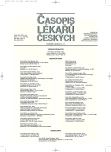Relation between dietary and physical activity patterns and obesity in seven year old children – current situation – WHO study
Authors:
Radka Braunerová 1; Marie Kunešová 1; Bohuslav Procházka 2; Jana Vignerová 3; Jana Pařízková 1; Jitka Riedlová 3; Hana Zamrazilová 1; Martin Hill 1; Alena Šteflová 4
Authors‘ workplace:
Endokrinologický ústav Praha, Centrum pro diagnostiku a léčbu obezity
1; Pediatrická ambulance, Kutná Hora
2; Státní zdravotní ústav, Praha
3; Kancelář WHO v České republice, Praha
4
Published in:
Čas. Lék. čes. 2010; 149: 533-536
Category:
Original Article
Overview
Background.
Childhood obesity is a global health problem. For monitoring of trends in obesity prevalence and comparison between countries standardized methods are necessary. WHO/Europe launched the “Childhood Obesity Surveillance Initiative” project in 2006 aiming to monitor childhood obesity and associated factors in European countries. This paper provides an overview of the situation in the Czech Republic with focus on diet and physical activity.
Methods and Results.
The cohort included 1704 seven-year olds who were examined by paediatricians in 2008 (essential anthropometric measurements). Questionnaires on children’s eating habits, physical activity, family, and school environment were filled in. Statistical methods employed. Multivariate regression with reduction of dimensionality (bi-directional orthogonal projection to the latent structure), one-way ANOVA.
Low-fat milk intake frequency was positively correlated with BMI (p = 0.0001), while full-fat milk intake was negatively correlated (p = 0.005). These results probably reflect the change in the diet due to increasing BMI. Number of preventive school programmes aimed on health promotion was negatively associated with BMI (p = 0.026).
Conclusions.
Surprisingly, low-fat milk consumption was associated with higher BMI in seven years old children, while full-fat milk consumption was associated with lower BMI. School preventive programmes positively affect children’s weight.
Key words:
childhood obesity, eating habits, prevention.
Sources
1. WHO/Europe. Nutrition. Facts and figures. .
2. Procházka B, Stožický F. Výskyt rizikových faktorů ischemické choroby srdeční u dětí. Cor Vasa 2009; 51: 397–403.
3. Krassas GE, Tzotzas T. Do obese children become obese adults: childhood predictors of adult disease. Pediatr Endocrinol Rev 2004; 1(Suppl 3): 455–459.
4. Freedman DS, et al. The relation of overweight to cardiovascular risk factors among children and adolescents: the Bogalusa Heart Study. Pediatrics 1999; 103: 1175–1182.
5. Lisá L. Typy a následky dětské obezity. In: Pařízková J, Lisá L, et al. Obezita v dětství a dospívání. Praha: Galén 2007; 107–124.
6. Fraňková S. Psychologické aspekty dětské obezity. In: Pařízková J, Lisá L, et al. Obezita v dětství a dospívání. Praha: Galén 2007; 175–192.
7. Matiegka J. Somatologie školní mládeže. Praha: Nakladatelství české akademie věd a umění 1927.
8. Lhotská L, et al. V. celostátní antropologický výzkum dětí a mládeže 1991 (České země). Antropometrické charakteristiky. Praha: Státní zdravotní ústav 1993.
9. Libuda L., Kersting M. Soft drinks and body weight development in childhood: is there a relationship? Curr Opin Clin Nutr Metab Care 2009; 12: 596–600.
10. James J, Kerr D. Prevention of childhood obesity by reducing soft drinks. Int J Obes (Lond) 2005; 29(Suppl 2): S54–S57.
11. O’Connor TM, et al. Beverage intake among preschool children and its effect on weight status. Pediatrics 2006; 118: e1010–e1018.
12. Huh SY, et al. Prospective association between milk intake and adiposity in preschool-aged children. J Am Diet Assoc 2010; 110: 563–570.
13. Kunešová M, et al. Overweight in Czech children and adolescents – association with parental obesity and socioeconomical factors. J Publ Health 2007; 15: 163–170.
14. Briefel RR, et al. School food environments and practices affect dietary behaviors of US public school children. J Am Diet Assoc 2009; 109(Suppl 2): S91–S107.
15. Fox MK, et al. Association between school food environment and practices and body mass index of US public school children. J Am Diet Assoc 2009; 109( Suppl 2): S108–S117.
16. Bener A. Obesity and low vision as a result of excessive Internet use and television viewing. Int J Food Sci Nutr 2010; 21 (Epub ahead of print).
17. Davison KK. Cross-sectional and longitudinal associations between TV viewing and girls’ body mass index, overweight status, and percentage of body fat. J Pediatr 2006; 149: 32–37.
18. Zamrazilová H, et al. Vliv časné postnatální výživy u předčasně narozených dětí na jejich atropometrické a hormonální charakteristiky ve věku 10 let. Čas Lék čes 2007; 146: 278–283.
19. Rolland-Cachera MF, et al. Influence of macronutrients on adiposity development: a follow up study of nutrition and growth from 10 months to 8 years of age. Int J Obes Relat Metab Disord 1995; 19: 573–578.
20. Pařízková J. Interaction between physical activity and nutrition early in life and their impact on later development. Nutr Res Rev 1998; 11: 71–90.
Labels
Addictology Allergology and clinical immunology Angiology Audiology Clinical biochemistry Dermatology & STDs Paediatric gastroenterology Paediatric surgery Paediatric cardiology Paediatric neurology Paediatric ENT Paediatric psychiatry Paediatric rheumatology Diabetology Pharmacy Vascular surgery Pain management Dental HygienistArticle was published in
Journal of Czech Physicians

Most read in this issue
- Drug treatment of obesity – current situation and perspectives
- hyperparathyroidism as a cause of hypercalcemia in a patient with breast cancer
- Relation between dietary and physical activity patterns and obesity in seven year old children – current situation – WHO study
- Relation between insulin secretion and action – study of genetic determination
